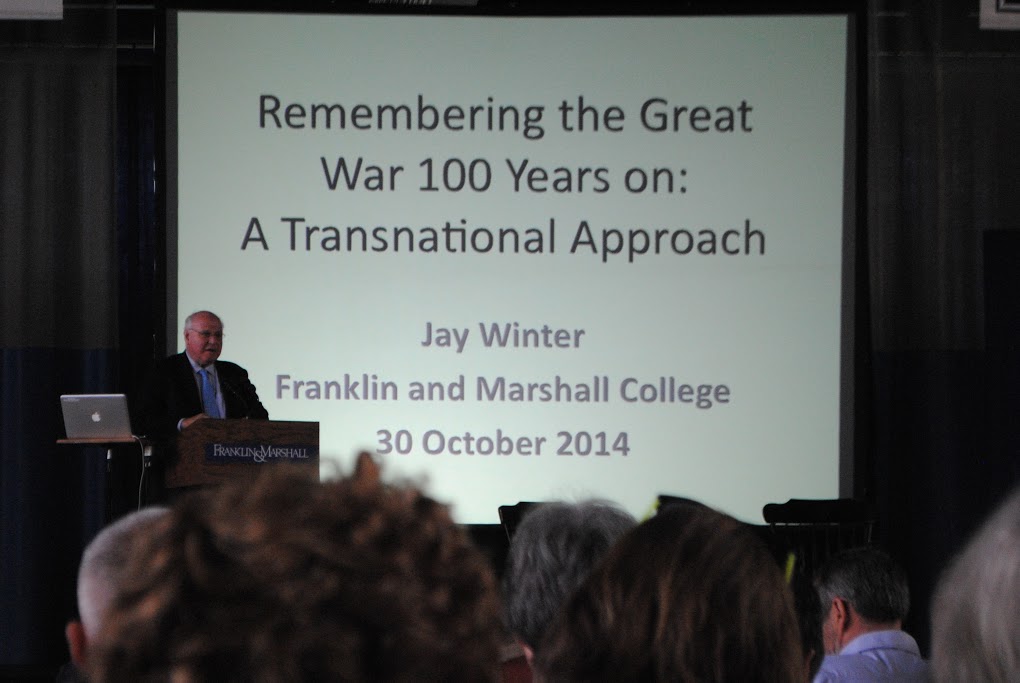By Samantha Greenfield, Staff Writer ||

Mayser Center. He spoke of memory and commemmoration of previous times of conflict. Photo by Emma Brown
This past week’s Common Hour, the audience had the pleasure of listening to distinguished historian and this year’s Mueller fellow, Jay Winter. This common hour was titled “Making Sense of our Violent Times: The First World War in Transnational Perspective.” Winter is one of the worlds leading experts of World War I and is a professor at Yale
University.
Winter began by talking about memory; two things have happened in academics since the 1960s that have largely shaped memory’s increasing role in our society. The first is that, in the 60s, there was a large expansion in higher education and, with that, came the appearance of the largest group of educated citizens in history. This has made memory a so-called “consumable good.”
Winter said that, with the increase in consumers of memory, there has been a “memory boom”; meaning that there has been a move towards making institutions of memory.
The second thing is sociologists have found that there has been secularization, a move away from religious institutions. Winter says it is not that we have lost the
sacred.
“The sacred has simply moved to institutions of memory nearby,” Winter said.
Winter says the way in which we understand war today is very important in understanding the memory boom of the 20th century. Since the 1980s, there have been changes in the way society recognizes and interacts with memory. For example, the first Holocaust archives were created in the 80s and the 1982 Vietnam memorial. Winter says these actions sent a particular message.
“Those who know the capacity of evil in the world and have survived to tell the tale are moral witnesses,” he said.
The remembrance of the two world wars during the 1980s served as a pacifist movement.
Winter tells the audience about the museum he was asked to create in France to remember the Battle of the Somme. A French politician whose father fought in the First World War wanted to erect this museum to honor him. His father, whom he wanted to honor, had come back from war a broken man who beat his son and wife. This politician, who was now in his late 70s, wanted to make peace with his father through this museum.
Winter suggested this museum be made about the whole war and also made it linked to
scholarship.
Moving forward with the museum, the next question was how to design it. Winter says, this is where a bit of serendipity came in. While Winter was on vacation in Switzerland, he stopped at the grand art gallery in Basel and saw a painting of Jesus that knocked him over. It was a painting of Jesus by Hans Ho in which he is dead in a tomb. The absolute death of Jesus depicted in this painting would require unremitting faith to believe that this man would rise on Easter Sunday.
The horizontality of Jesus was so different to Winter that he designed his museum around this idea. Every museum of war is created around the vertical. Vertical stands for hope and strength, while horizontal signals mourning. The First World War was fought horizontally, in the trenches. Winter wanted to find a way to force the vision of the museum’s audience down. So the Museum has trenches in the floor, in which artifacts are laid under a glass and displayed. They are two feet deep, 20 feet long, eight feet wide.
“By forcing the vision of the public down, we were making a statement about war which was different from that of many other places in the world,” Winter said.
On the walls of the museum are the medical instruments. The artillery and the weapons take up so much more space in the museum, showing how much stronger the offense was instead of the defense or the care for the soldiers. The museum contains artifacts from all sides of the war, which represents the transnationality of the war.
Winter then went on to explain how the war was revolutionary, not only in its transnationality but also in its killing of civilians. The First World War is the first war where civilians were actually targeted. Furthermore, it was revolutionary because it tied family and world histories together because of the mass casualties of soldiers and civilians alike. The First World War killed so many, and for what purpose? Winter argues that the Second World War would have been harder to avoid because of all of the evil powers in the world such as Hitler; however, the First World War could have been avoided.
“The First World War was an opening to a monstrous period of violence that is, unfortunately, our fate to deal with today,” Winter concluded.
Everyone is a target of war now because the First World War normalized the killing of civilians. Winter argued that, now, no one is safe.
Senior Samantha Greenfield is a staff writer. Her email is sgreenfield@fandm.edu.